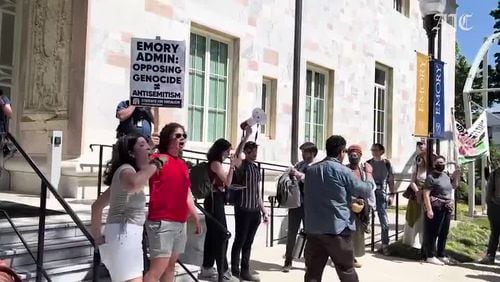Most people know all about legendary sports heroes Joe Louis and Jackie Robinson.
But how many people really know about boxing great Jack Johnson? Or how many know about Martin Dihigo, a Cuba-born baseball player who was elected to the U.S., Mexican, Venezuelan and Cuban halls of fame? He is considered by many to be the best and most versatile Cuban player ever.
The Manuscript, Archives & Rare Book Library at Emory University is expanding its collection of African-American sports memorabilia. Included in the growing collection is a promotional flier touting the “Roar of the Crowd with the one and only Joe Louis” and a ticket stub to the Louis-Max Schmeling 1938 title fight. Also on display is a rare book, published in the late 1800s in London, about African-American boxers and a ticket stub from the National Colored All-Star Baseball Game held Aug. 13, 1944.
Some items were donated, while others were acquired at auctions or book fairs.
“I think it’s added a certain dimension to our collection of African-American culture,” said Ginger Cain, interim director of the MARBL. “Sports is a great equalizer in many ways. Every piece has a story and a connects to something else.”
For instance, the ticket stub to the Louis-Schmeling match was once owned by acclaimed author Richard Wright, who covered the fight for the Daily Worker, a newspaper published by the Communist Party USA.
“It’s wonderful web of personal stories,” Cain said.
And hopefully, there will be new stories to tell as the collection grows, said Randall Burkett, the curator of African-American collections at the library.
This isn’t the first such project for Emory. The library recently received a matching grant to preserve and digitize dozens of African-American scrapbooks, including collections belonging to writer Alice Walker and black vaudeville performer Johnny Hudgins.
Burkett hopes the collection, which is available to the public, will “spur someone to do research or work on African-Americans sports figures. “We’re not just going to put these items in cases. They’re here for people to look at them and study them” so they can understand African-American history and culture.
He said plans include collecting interviews with historic sports figures. Famous athletes, black and white, have often been treated as orphans in academia and Emory wants to change that view.
People remember the scandals but not the challenges that many early players had to overcome, professionally and personally.
“The collection is very small. We’re just at the beginning,” Burkett said.
Particularly interesting is the link to the country’s civil rights movement. Many African-American figures may have emerged victorious in their sports, but they couldn’t stay in the same hotels or eat in the same restaurants as their white counterparts. Many of the figures such as Robinson helped break down barriers in their respective sports. “They’re much more than entertainers,” Burkett said.
The collection also underscores how prevalent racism was. It wasn’t unusual for an African-American boxer to win a match only to have it ruled otherwise by skewed judging.
Dana F. White, a faculty consultant to the library’s African-Americans in Sports Collection, said Louis’ manager often stressed how important it was for Louis to knock out his opponent. If not, the fight would be subject to judges’ decision and his opponent possibly declared the winner. After the opponent was knocked out, said White, Louis was told to stand there and “be cool, so people will think you’re a nice guy.”
Pellom McDaniels III, a consultant curator, former NFL player and an expert on African-Americans in sports, said the collection is just the beginning.
“In sports, we have a tendency to not look at sports seriously,” he said. “We look at it as an area of leisure and recreation. For some people it’s very trivial. But sports, for the most part, reflects the progress of the people. When you think about the civil rights movement, how can we forget Tommie Smith and John Carlos? Just that image.”
U.S. sprinters Smith and Carlos became notable for giving the black power salute during the Mexico City Olympics in 1968. Their iconic photo captured an important moment in U.S. and civil rights history.
“The image is bold and brave and it is representative of black folks and their unwillingness to acquiesce to white supremacy,” McDaniels said. “You have to be open to what is in front of you to really appreciate where it fits into the larger story. ... How do we write off what Jack Johnson did? How do we write off what Isaac Murphy, Joe Louis, Jackie Robinson and Jesse Owens did? Sports participation for blacks was a form of resistance.”
-------------------------
To view the collection
Emory University’s Manuscript, Archives, & Rare Book Library is on the 10th floor of the Robert W. Woodruff Library, 540 Asbury Circle, Atlanta. Exhibitions are free and open to the public from 9 a.m. to 5:30 p.m. Mondays to Saturdays. To use materials, people must register and present a photo ID. 404-727-6887, www.marbl .library.emory.edu.
About the Author





